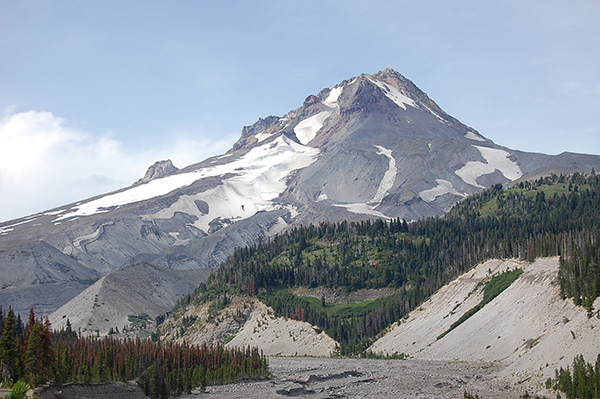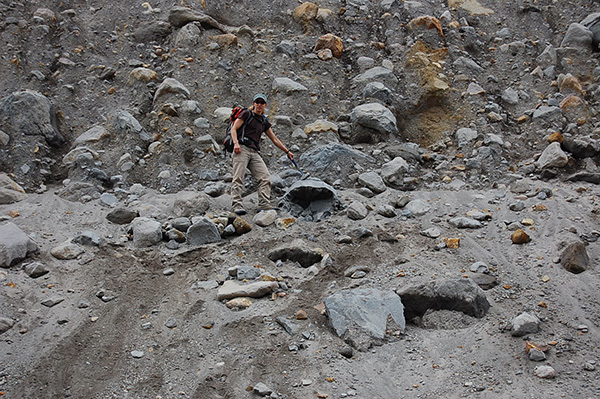
by Lauren Milideo Monday, June 9, 2014

New research looks at the eruptive potential of Mount Hood in Oregon. Credit: Kari Cooper.
The term “magma chamber” might evoke thoughts of a roiling mass beneath a volcano, ready to blow at any moment. But in a recent study in Nature, researchers found that magma beneath Oregon’s Mount Hood spends minimal time in this eruptible state. Instead, magma remobilization and eruption occur within a short time frame.
Volcanic eruptions at the surface are dramatic, but the scene belowground is also action-packed, says Kari Cooper, a geochemist at the University of California at Davis and lead author of the new study. Magma chambers are “very dynamic places. You have a lot going on down beneath these volcanoes,” Cooper says.
Cooper and her colleagues wanted to understand more about the magma chamber beneath Mount Hood, a volcano about 70 kilometers east of Portland that last erupted in the 1790s. Specifically, the team was curious how long magma spends as “a very mobile liquid that’s easy to erupt” versus how long it spends as “a magma mush,” Cooper says.
How magma works is a challenging question, says George Bergantz, a physical petrologist at the University of Washington who wasn’t involved in the study, largely because “everything has to be inferred from the materials that are erupted … and then one has to infer the whole history of the process from that one material, from that one snapshot in time.”

Lava from the Old Maid eruption on Mount Hood about 220 years ago. Credit: Kari Cooper.
Magma’s physical state is temperature-dependent; mineral crystals, growing layer by layer somewhat like tree rings, record the temperature and conditions of the magma from which they’re forming over time, Cooper says. To explore the magma’s shifting temperature through time, the team focused on Mount Hood, obtaining representative rock samples from the two most recent eruptions — Timberline, approximately 1,500 years ago, and Old Maid, about 220 years ago. They examined the total life spans of the plagioclase crystals in the samples, as well as the diffusion of the trace element strontium that had occurred within the crystals. Combining this information with knowledge of strontium’s temperature-dependent rate of diffusion through crystals, they determined how long the crystals had spent at or above 750 degrees Celsius (which, for these magmas, is the temperature cutoff known to distinguish crystal-dominated, slow-moving magma mush from more mobile, eruptible magma).
Next, the team expanded their study to more diverse systems, assembling a dataset of analyses of more than 100 crystal and mineral samples such as plagioclase and clinopyroxene from 22 previously studied volcanic systems around the world, again employing trace-element diffusion and comparing how long the crystals had spent at various temperatures to their total ages.
The authors also compared the Mount Hood and global sample crystals’ sizes to their growth rates, which, because crystals only grow in a certain critical temperature range, yielded an independent constraint on the time the magma spent in this critical range between more liquid and solid states. In the end, they realized that the duration spent in this critical temperature range was typically much less than the crystals’ total life span.
The team established the maximum time the crystals could have spent in a mostly liquid state, concluding that the Mount Hood magma likely spent “less than 1 percent but certainly less than 12 percent of its time in this highly mobile mostly liquid state,” Cooper says. The findings, she adds, were “a surprise.”
The study shows that “the transition from dormancy to being very mobile, hence eruptible, happens very quickly,” Bergantz says. The fact that the team used multiple approaches is also key, Bergantz notes: “A diversity of efforts to understand how magmas and volcanoes work will benefit from this study.”
The obvious next steps are to perform similar tests on other volcanoes and to build a database of what volcanoes behave in different ways, Cooper says.
“If we’re going to be able to eventually forecast what volcanoes are going to do in the future, we need to have some picture of what’s happening beneath the surface, in order to interpret all of the monitoring data we have,” Cooper says. And with the fields of geophysical monitoring, theoretical computer modeling and geochemistry enjoying greater interaction than ever before, new doors are opening, Cooper adds. “In the next 10 years or so we’re going to make some pretty big advances in understanding these systems.”
© 2008-2021. All rights reserved. Any copying, redistribution or retransmission of any of the contents of this service without the expressed written permission of the American Geosciences Institute is expressly prohibited. Click here for all copyright requests.